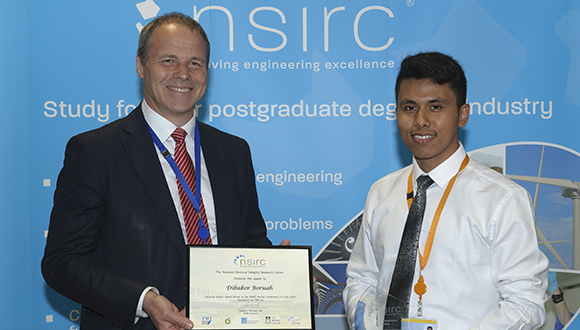Mon, 22 July, 2019
 2019 TWI Industrial Impact Award, presented to Dibakor Boruah by Dr Paul Woollin, TWI Director of Research. Photo: NSIRC / TWI Ltd
2019 TWI Industrial Impact Award, presented to Dibakor Boruah by Dr Paul Woollin, TWI Director of Research. Photo: NSIRC / TWI Ltd
Research that could save time and money on structural repairs in the aerospace industry took first place in the Industrial Impact Awards at the NSIRC Annual Conference this year.
The awards, organised by NSIRC as part of the conference, recognise students’ research that makes a significant contribution or takes an innovative approach to solve an industrial problem.
Third year PhD student Dibakor Boruah’s work on ‘Structural Integrity Assessment of Cold Sprayed Ti-6Al-4V Alloy for Repair Applications’ stood out as being of enormous benefit to the Additive Manufacturing (AM) research community as well as the industry itself.
The award follows Dibakor’s success earlier this month in winning The Armourers and Brasiers’ Gauntlet Trust and The Welding Institute PhD Student of the Year Award, which formally recognises individual achievements in professional development.
Aircraft structural components are intricate and expensive, due to their manufacturing process complexities and the use of high-performance material.
Titanium Alloy Ti-6Al-4V
Titanium Alloy Ti-6Al-4V is used in many aircraft components owing to its well-known characteristics of high strength, excellent fatigues and corrosion resistance, and relatively low density. However, they are highly susceptible to in-service damage such as wear, corrosion, fatigue cracks or foreign object damage.
It is extremely important to replace or repair damaged parts to ensure continued airworthiness and performance. Remanufacturing of aerospace components recovers materials and promotes sustainable manufacturing and a circular economy, plus deliver significant financial savings of 30-70% of the cost of replacement.
In the past, there were no feasible or efficient methods to remanufacture damaged aircraft components in a cost-effective way, however, the emergence of technologies such as Cold Spray (CS) has made the process more economically viable.
To safely operate repaired load-bearing parts, structural integrity is an imperative factor in determining the safe life and damage tolerance performance. Dibakor’s work uses Ti-6Al-4V and CS method to demonstrate this.
A number of approaches have been taken, including optimisation of the CS process parameters, establishing a novel experimentation procedure to analyse real case CS repair geometries, the effect of post-deposition thermal treatments, and structural integrity assessments in terms of static, fatigue and damage tolerance performance taking into account of residual stresses. Dibakor is also looking at laser-assisted cold spraying of Ti-6Al-4V as an alternative method of repair.
Dibakor said “It has been a great experience doing my PhD in an industry-led academic research centre. NSIRC facilitates an efficient environment for conducting research with the constant support from TWI industrial experts along with academic supervision to solve a real-world problems."
"NSIRC also supported me to carry out experiments in leading external laboratories, attending prestigious international conferences and gaining international collaborations. After finishing my PhD, I aspire to be a part of TWI or its innovation network and contribute towards research for enhancing structural integrity of additively manufactured components.”
The understanding of the structural integrity of CS will allow the industry to explore different methods for repair, improving their services and products whilst aiming to improve the life of repaired components.
The work also promotes sustainable manufacturing and a circular economy, and enhances the safety of life and property.
The number of publications being generated is an indication of the novelty of the work being performed and its importance.
Dibakor has two published journal articles, one each in “Surface and Coatings Technology”, and “Multidiscipline Modelling in Materials and Structures”, with an article in the process of being published and a further three in the writing process. He has also presented his work at three international and six UK conferences to date.
The runners up in this year’s Industrial Impact Awards were:
- Angelo La Rosa
- Gowtham Soundarapandian
- Andrew Sandeman
For more information, or to speak to Dibakor about his research, please contact enquiries@nsirc.co.uk.